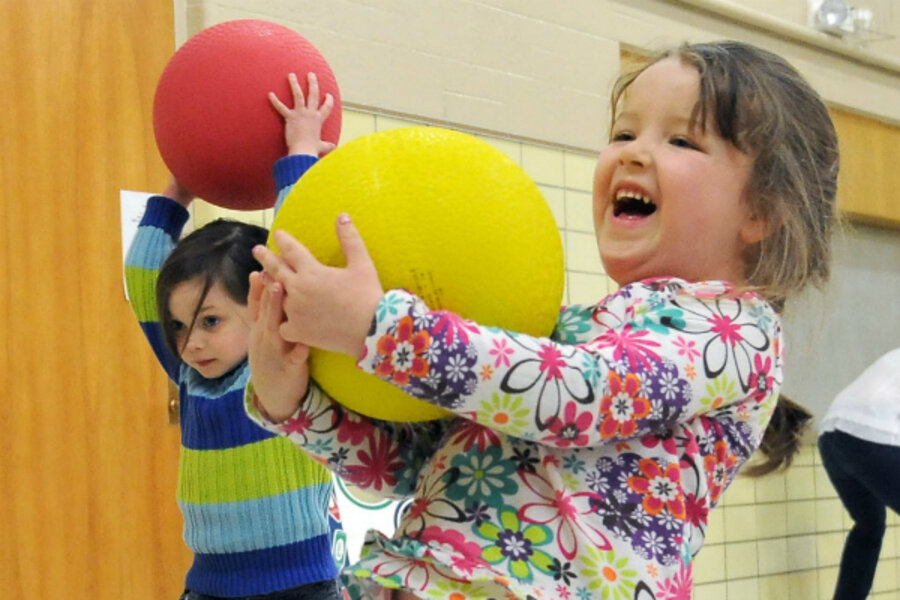Play at school: Recess, and these games, boost child development
Loading...
The American Academy of Pediatrics (AAP) has released a policy statement that recognizes the value of recess for children. The AAP wrote:
Recess during school offers children cognitive, social, emotional, and physical benefits they don’t get through academics alone.
According to the AAP:
- Recess is “a necessary break in the day” and “should not be withheld for academic or punitive reasons.”
- Recess offers important breaks from concentrated classroom work, which allow children to be “more attentive and more productive in the classroom.”
- Recess “promotes social and emotional learning and development” through “peer interactions in which they practice and role play essential social skills.” Children learn negotiation, cooperation, sharing, and problem solving, as well as coping skills, such as perseverance and self-control.
- Recess offers benefits that are “unique from, and a complement to, physical education — not a substitute for it.”
- Recess can help offset risks to childhood obesity.
The AAP also noted that some schools cite safety issues as a barrier to recess and free play and offers steps to protect children while offering free and unstructured play.
The AAP statement provides a large boost to those who have been advocating for recess and free play in the face of calls for more academic and scheduled time for children. Last year, an important study published by the AAP revealed that pre-school children are far too sedentary for their physical and psychological health. The recent policy statement notes that “even minor movement during recess counterbalances sedentary time at school and at home.”
Read the complete AAP Policy Statement on The Crucial Role of Recess in School.
Many of us grew up with free play and recess games, some of which were made up on the spot, and some of which we learned from others. Here are a few games that kids (and even parents and teachers) may not know, which can add to recess and other fun and play. Many more playground and other game instructions can be found in my book, Fed Up with Frenzy: Slow Parenting in a Fast-Moving World.
Playground Games
These fun, easy games require little or no equipment and have been creating memories for generations.
Duck, Duck, Goose
South Asians know it as Kho Kho, Ghanaians as Antoakyire. German children play a version called Plumpsack, which involves dropping a handkerchief at one player’s spot. Young children play this timeless game around the world.
Players sit in a circle, facing each other. Choose a player to be it. It walks around the outside of the circle, tapping each person on the head and saying, for each tap, “duck”, “duck”, “duck”. Finally, it taps a person on the head and says, “goose” and begins to run around the outside of the circle. The person who is tapped as a goose gets up and chases it around the circle. If the goose is able to tap it before he or she sits down in the goose’s spot, then that person is it again. If the goose does not tag it, then the goose becomes the new it.
Red Light, Green Light
Another game played around the world, Red Light, Green Light has many charming variations. In the Czech Republic, it’s called, Cukr, káva, limonáda, čaj, rum, bum! (“Sugar, coffee, lemonade, tea, rum, boom!”)
One player is chosen to be the stoplight. That person turns his or her back to the group, which forms a line approximately 30–90′ away (depending on the ages of players). The stoplight calls out, “Green light!” and the players advance toward the player who is the stoplight as quickly as they can. When the stoplight wishes, he or she calls out, “Red light!” while turning around to see the runners. The runners must stop immediately. Any player caught moving after a call of “red light” has to go back to the starting line. “Green lights” and “red lights” are repeated until the first player reaches and tags the stoplight and is declared the winner. If all the players are out before they reach the stoplight, then the stoplight wins that round. The winner becomes the new stoplight.
Four Square
Not sure what to do with that four-square court painted on your school playground? This classic game couldn’t be easier or more inclusive. If you don’t have a four-square court, you can easily draw your own with chalk.
You’ll need:
A standard-size rubber playground ball
A court, or chalk to draw one
If there isn’t a court, draw a large square, approximately 16′ × 16′. Divide that into four squares, each 8′ × 8′. Letter the squares clockwise, from A to D. The player in the A square begins by bouncing the ball once in his or her own square, then hitting it underhand so it bounces into the D square. The receiving player then hits the ball into another square, with play continuing until the ball bounces more than once or goes out of bounds. When that happens, the player who didn’t hit the ball in time, or hit it out of bounds, moves to the D square, and the other players move up in the alphabet. If there are more than four players, a waiting player in line replaces the one who would have moved into the D square, and that player goes to the back of the line. Play continues without anyone having to permanently leave the game.
Blob Tag
There are so many fun tag games, you needn’t limit yourself to basic tag. Try this fun variation:
Once a player is tagged by the person who is “it,” the two join arms and become a blob, which chases players together to try to tag them. Other players who are tagged also join arms and become part of the blob. Some play a version in which, when the blob reaches four people, two split off to become a new blob. The last person standing alone becomes the new “it.”
Jump-Rope Games
Jumping rope has gone in and out of fashion since ancient Egypt, when both men and women jumped over vines. It wasn’t until the 20th century that jumpers incorporated singsong games and rhymes. Many of these are passed down through the generations like oral history, with different regions using different chants. I learned many of these from my mom and passed them down to my daughter.
You’ll need:
One regular jump rope for one person, or a longer jump rope for two turners to turn while a jumper (or more) jumps.
The jumper jumps over the rope each time it hits the ground. Jumpers can jump in one jump each turn or take one big jump followed by one smaller jump each turn. A turn ends when the jumper fails to jump over the turning rope. The following are classic, easy jump-rope games. They don’t have tunes so much as chants, so they are especially easy to pick up.
A, My Name Is Alice
This is a fun add-on game that also calls for a little creativity and is different every time.
The first jumper starts with the letter A and fills in the blanks in the following sentence, however he or she chooses:
A my name is ____ and my husband’s name is ____ and we live in ____ and we sell ____.
For example: A my name is Alice and my husband’s name is Al and we live in Albuquerque and we sell apples.
If the jumper hasn’t tripped up, he or she moves on to the letter B: B my name is Betty and my husband’s name is Bob and we live in Boise and we sell beans.
Jumpers move through the alphabet as long as their turns last. New jumpers usually start with A, which makes it easy to compare how far each jumper gets, and choose new names.
Teddy Bear, Teddy Bear
This jump-rope game is a little more advanced, as it requires players to pantomime the activity they are singing about (to the best of their abilities) as they jump.
Teddy Bear, Teddy Bear, turn around.
Teddy Bear, Teddy Bear, touch the ground.
Teddy Bear, Teddy Bear, tie your shoe.
Teddy Bear, Teddy Bear, that will do!
Teddy Bear, Teddy Bear, go upstairs.
Teddy Bear, Teddy Bear, say your prayers.
Teddy Bear, Teddy Bear, turn out the lights.
Teddy Bear, Teddy Bear, say good-night!
Apples, Peaches, Pears, and Plums
Apples, peaches, pears, and plums.
Tell me when your birthday comes.
January, February, March…
Count one month for each turn of the rope successfully jumped.
I hope you all take the AAP recommendations to heart and enjoy recess and play!
The Christian Science Monitor has assembled a diverse group of the best family and parenting bloggers out there. Our contributing and guest bloggers are not employed or directed by the Monitor, and the views expressed are the bloggers' own, as is responsibility for the content of their blogs. Susan Sachs Lipman blogs at Slow Family Online.






